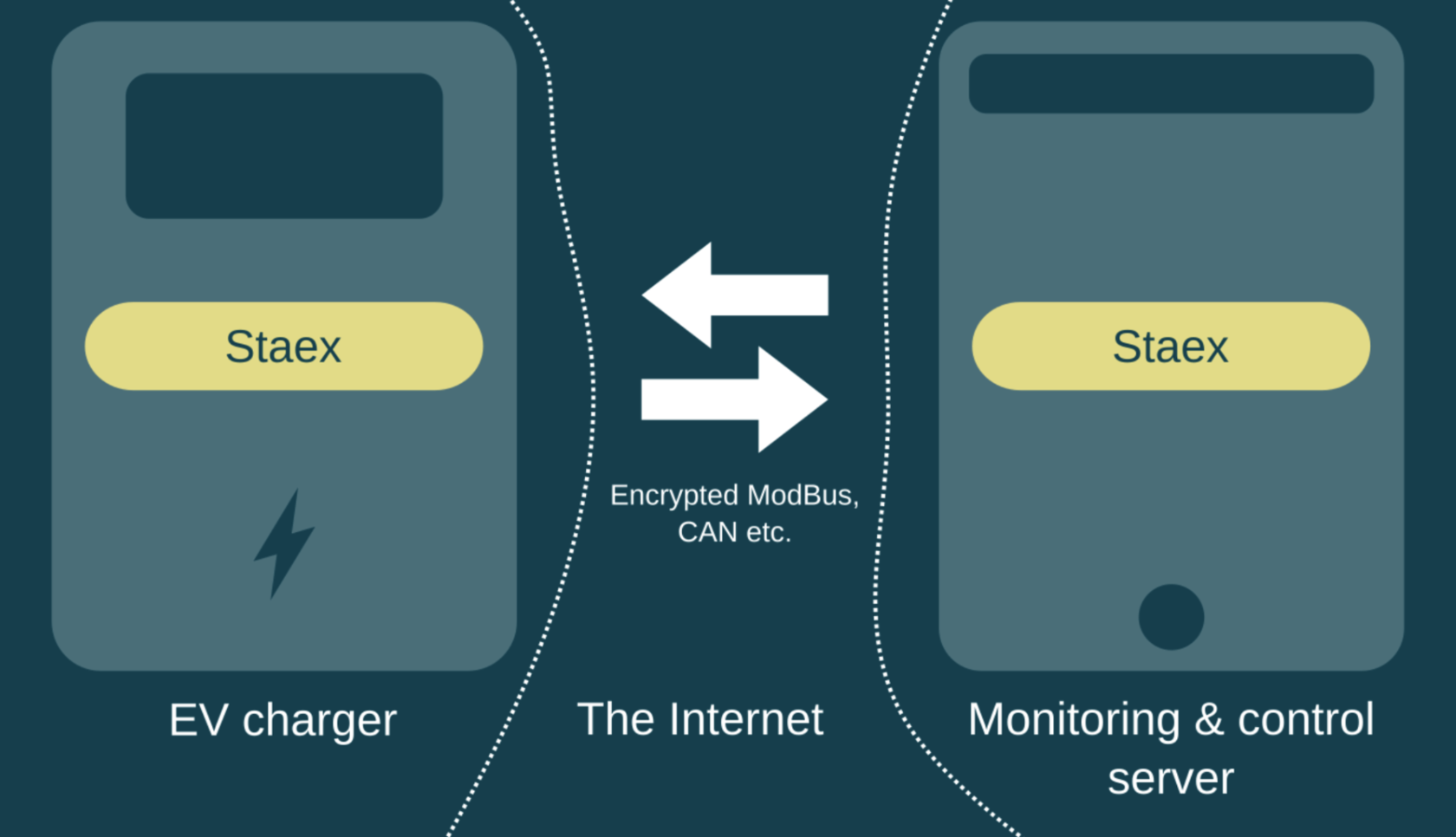Secure and Reliable Mobile Charging Infrastructure with Staex
2023-02-21
The problem with securing communication to energy infrastructure is that it often uses low-level industry-standard protocols (e.g. ModBus, CAN, ProfiBus) that do not have security built in.

For a long time energy infrastructure used SCADA systems for control and monitoring. These systems were designed to be used in local area networks where security is guaranteed by firewalls. This in contrast to mobile and even stationary energy infrastructure (e.g. EV charging stations and the batteries for these stations) operate in a global network. The security is no longer guaranteed; approaches to secure the communication channels are critical requirements.
The problem with securing communication to energy infrastructure is that it often uses low-level industry-standard protocols (e.g. ModBus, CAN, ProfiBus) that do not have security built in. Changing these protocols is costly as they are already built into the equipment and many of them are standardized. The current solution to this problem (until the protocols are developed) is to attach a computer or a router to the piece of equipment that retransmits the data from the equipment over a global network. This is where Staex fits in.

Securing legacy unencrypted protocols
Staex is an overlay peer-to-peer network that provides secure connectivity over a global network. Staex features end-to-end encryption, service discovery and also service orchestration and batch job scheduling on top of the network. With Staex the packets generated by legacy insecure protocols are sent over a secure tunnel to be received on the other end by the software that speaks those protocols. With Staex you do not have to write an additional piece of software that translates these protocols into some handcrafted encrypted alternatives and back — the network does the translation back and forth automatically. This translation is transparent for the applications, i.e. you do not have to rewrite your programs to work with the new network.
Flattening the network and enabling IT automation
Staex flattens the network of your energy infrastructure. Every piece of equipment gets its own unique address in the network that is also a public key of the node. As such it can not be duplicated or spoofed unless the private key of the node is compromised. Flattening the network allows you to use state-of-the-art IT automation tools (i.e. Ansible, Kubernetes) to configure, monitor and maintain the energy infrastructure equipment with the same ease as cloud servers.
Lightweight service orchestration
Besides secure communication Staex provides orchestration capabilities that are optimized for resource-constrained battery-powered devices. Staex orchestrator allows you to deploy native applications and application containers to any node in the network, monitor their status and inspect log files. In addition, Staex allows you to run one-shot and periodic batch jobs for even more automation. The orchestrator is a lightweight alternative to state-of-the-art tools like Kubernetes that is optimized for low resource consumption, that requires no configuration, and that is readily available on any node where Staex runs.
Finally, Staex is fully distributed and decentralized with no single point of failure. Its architecture is inspired by the proliferation of web 3.0, blockchain and crypto technologies that encourage federated infrastructure, peer-to-peer communication and zero trust. As such Staex is a solid and modern foundation for the current energy infrastructure, but also would allow you to expand your infrastructure capabilities to be in line with the future trends.
Greenbox and Staex partnership
Greenbox and Staex are building secure, reliable, and distributed mobile EV charging as well as green hydrogen infrastructure and making it accessible and convenient for everyone. The infrastructure will enable capabilities like on-demand charging for autonomous vehicles, remote monitoring and management of charging stations, and integration with smart grid systems. These capabilities will bring Industry 4.0 closer to reality by enabling more efficient use of energy resources and supporting the growth of connected, autonomous transportation systems.
The companies are currently in the midst of the development to have an off-grid green fueling available for commercial use in 2023.
Staex's end-to-end encryption, flat networking, and orchestration capabilities enable a fully connected, secure, reliable, and maintainable future of mobile EV charging.
From the very beginning of our Greenbox project one of the most important questions was the connection of devices within the network. In order to follow current trends in the IoT sphere, this connection must be secure, light-weighted, easily extendable, and flexible. More than that, modern DevOps and IT automation tools and technologies must be supported. Considering current velocity of IT development, especially in the light of AI, automotive driving, and Web 3.0, no mistake should be made. Only capable and reliable companies must be taken into consideration.
Greenbox performed a long-processing research of the market trying to find the best candidate for the possible partnership. From the very beginning Staex showed not only full capabilities and capacities of mentioned parameters, but a huge interest and motivation of working together. It is a perfect combination of professionalism and human qualities. We are more than happy to have Staex as the main IT partner.
